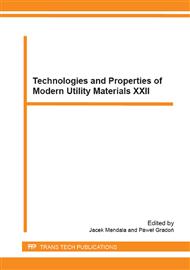[1]
L. Socha et al., Assessment of Briquetting Fluxing Agent Influence on Refining Effects of Slag during Steel Processing at the Secondary Metallurgy Unit. In METAL 2011: 20th Int. Metal. Conference, 163-169, ISBN 978-80-87294-24-6.
Google Scholar
[2]
K. Michalek et al., Physical Modelling of bath Homogenization in Argon Stirred Ladle. Metalurgia 48 (4) (2009) 215-218.
Google Scholar
[3]
K. Janiszewski, Refining of liquid steel in a tundish using the method of filtration during its casting in the CC machine, Archives of Metallurgy and Materials 58 (2) (2013) 513-521.
DOI: 10.2478/amm-2013-0029
Google Scholar
[4]
M. Tkadlečková et al., Setting of Numerical Simulation of Filling and Solidification of Heavy Steel Ingot Based on Real Casting Conditions, Materiali in tehnologije 46 (3) (2012) 7-10.
Google Scholar
[5]
J. Šesták, Measurement of thermophysical properties of solid (in Czech), 1st ed., Academia, Prague 1982, ISBN I-177812-1060/83.
Google Scholar
[6]
A. Blažek, Thermal analysis (in Czech), 1st ed., SNTL, Prague, 1972, ISBN I-97406-8732/72.
Google Scholar
[7]
J. Miettinen, Calculation of solidification-related thermophysical properties for steels. Metallurgical and Materials Transactions B, 28B (1997) 281-297.
DOI: 10.1007/s11663-997-0095-2
Google Scholar
[8]
W.J. Boettinger, U.R. Kattner, On differential thermal analyzer curves for the melting and freezing of alloys, Metallurgical and Materials Transaction A 33A (2002) 1779-1794.
DOI: 10.1007/s11661-002-0187-1
Google Scholar
[9]
G. Grünbaum et al., A Guide to the Solidification of Steels, Jernkontoret, Stockholm 1977, ISBN 91-7260-156-6.
Google Scholar
[10]
D.A. Porter et al., Phase Transformations in Metals and Alloys, 3rd ed., CRC Press, Boca Raton 2009, ISBN 0-7487-5741-4.
Google Scholar
[11]
J.C. Zhao, Methods for Phase Diagram Determination, Elsevier, Oxford 2007, ISBN 0-0804-4629-9.
Google Scholar
[12]
W. Banda et. al., Liquidus temperature determination of the Fe-Co-Cu system in the Fe-rich corner by thermal analysis, Journal of Alloys and Compounds 461 (2008) 178-182.
DOI: 10.1016/j.jallcom.2007.07.045
Google Scholar
[13]
P.K. Gallagher, Handbook of Thermal Analysis and Calorimetry: Principles and Practice, 2nd ed., Elsevier, Oxford 1998, ISBN 0-4448-2085-X.
Google Scholar
[14]
B. Smetana et al., Phase Transformation Temperatures of Pure Iron and Low Alloyed Steels in the Low Temperature Region Using DTA, International Journal of Materials Research, 101 (3) (2010) 398-408.
DOI: 10.3139/146.110283
Google Scholar
[15]
T. Myslivec, Physico-chemical fundamentals of steelmaking (in Czech), 2nd ed., SNTL, Prague 1971, ISBN I-52483-6509/71.
Google Scholar
[16]
L. Šmrha, Solidification and crystallization of steel ingots (in Czech), SNTL, Prague 1983, ISBN 182664-14825/83.
Google Scholar
[17]
Unpublished information from the industrial partners (2008-2011).
Google Scholar
[18]
W. Dubowick, Thermal Arrest Measurements and their application in the investment casting, In Proc. of the 2nd Foundry Congress, Dusseldorf (1960).
Google Scholar
[19]
J.P. Aymard, P. Detrey, Industrial method for determining liquidus temperatures of steels - evaluation of solidification intervals, Fonderie, Paris, 29 (1974) 330 14.
Google Scholar
[20]
W. Roeser, H. T. Wensel, Stahl und Eisen 8 (1951).
Google Scholar
[21]
J. Štětina, Dynamic model of temperature field of continuously cast slabs (in Czech), Ph.D. thesis, VŠB-TU Ostrava, 2007. Available from World Wide Web: http: /ottp. fme. vutbr. cz/users/stetina/disertace/index. htm [cited 2012-08-30] (in Czech).
Google Scholar
[22]
O. Volkova, Mathematical Modelling and Experimental Investigation of the Rapid Solidification of Steels, Dissertation Thesis, Freiberg, Germany (2002) 138.
Google Scholar
[23]
H. Csichos, Fundamentals of Engineering, Springer, Berlin 2000, ISBN 3-540-66882-9.
Google Scholar
[24]
G. Meyer, E. Schiffner, Technical Thermodynamics, Fachbuchverlag, Leipzig 1989, ISBN 3-343-00221-6.
Google Scholar
[25]
ProCast 2009. 0, User's manual (released: Feb-09), ESI Group 2009 163.
Google Scholar
[26]
ProCast 2009. 0, User's manual (released: Feb-09). ESI Group 2009 175.
Google Scholar
[27]
K. Gryc et al., Determination of solidus and liquidus temperatures of the real steel grades by dynamic thermal analysis methods, Materiali in Tehnologije 47 (5) (2013) 569-575.
Google Scholar


